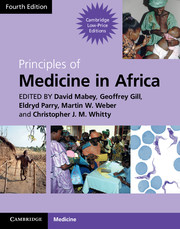Book contents
- Frontmatter
- Contents
- Contributors
- Foreword
- Section 1 Health and disease
- Section 2 Mother and child health
- Section 3 Infection: general principles
- Section 4 Major common infections
- Section 5 Bacterial infections
- Section 6 Viral Infections
- Section 7 Protozoal infections
- Section 8 Helminth infections
- 46 Intestinal helminths
- 47 Schistosomiasis
- 48 Lymphatic filariasis and loa loa
- 49 Onchocerciasis
- 50 Cysticercosis
- 51 Hydatid disease
- 52 Paragonimiasis
- 53 Trichinellosis
- 54 Guinea worm
- Section 9 Fungal infections
- Section 10 Non-communicable diseases
- Section 11 Diseases of body systems
- Section 12 Cancer and Palliative Care
- Section 13 Venoms and Poisons
- Index
- References
47 - Schistosomiasis
from Section 8 - Helminth infections
Published online by Cambridge University Press: 05 March 2013
- Frontmatter
- Contents
- Contributors
- Foreword
- Section 1 Health and disease
- Section 2 Mother and child health
- Section 3 Infection: general principles
- Section 4 Major common infections
- Section 5 Bacterial infections
- Section 6 Viral Infections
- Section 7 Protozoal infections
- Section 8 Helminth infections
- 46 Intestinal helminths
- 47 Schistosomiasis
- 48 Lymphatic filariasis and loa loa
- 49 Onchocerciasis
- 50 Cysticercosis
- 51 Hydatid disease
- 52 Paragonimiasis
- 53 Trichinellosis
- 54 Guinea worm
- Section 9 Fungal infections
- Section 10 Non-communicable diseases
- Section 11 Diseases of body systems
- Section 12 Cancer and Palliative Care
- Section 13 Venoms and Poisons
- Index
- References
Summary
Schistosomiasis is the generic name given to diseases caused by parasitic blood flukes of the genus Schistosoma. An older name, still widely used in Africa, is bilharzia. Of the three major species that commonly infect humans, two occur predominantly in Africa:
S. mansoni, a cause of intestinal schistosomiasis, also found in Brazil and the Caribbean; and
S. haematobium, the cause of urinary schistosomiasis, also found in the Middle East.
The third major species, S. japonicum, causes another form of intestinal schistosomiasis but is found only in the Far East. A minor species, S. intercalatum, causes infection but insignificant disease in small areas of Central Africa.
Schistosomiasis is typically a chronic infection. Adult worms slowly accumulate from early childhood over a period of 10 to 20 years, and the deposition of eggs in the tissues leads to fibrosis in the intestines and liver (S. mansoni) or the urinary tract (S. haematobium). Mild or moderate symptoms occur in most infected children: severe disease develops in later life in only a minority of these individuals. For detailed reviews of different aspects, the reader is referred to books edited by Jordan et al. (1993) and Mahmoud (2001).
- Type
- Chapter
- Information
- Principles of Medicine in Africa , pp. 441 - 452Publisher: Cambridge University PressPrint publication year: 2013
References
- 2
- Cited by

